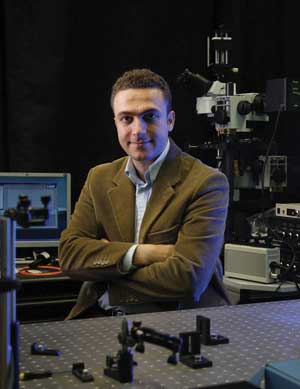Dr. Aydogan Ozcan has been busy. At 34, he has 22 patents and more than 15 pending patent applications for his inventions in nanoscopy, wide-field imaging, lensless imaging, nonlinear optics, fiber optics and optical coherence tomography – and his contributions have not gone unnoticed: He has received several major awards, including the 2011 Presidential Early Career Award for Scientists and Engineers, the 2013 SPIE BioPhotonics Technology Innovator Award, the 2011 Army Research Office Young Investigator Award, 2011 SPIE Early Career Achievement Award, the 2010 NSF Career Award and others.
 Ozcan was selected as one of the top 10 innovators by the US Department of State, US Agency for International Development, NASA and Nike as part of the LAUNCH: Health Forum organized in 2010. He also received the 2012 World Technology Award on Health and Medicine from the World Technology Network. Ozcan is an elected fellow of SPIE, a senior member of IEEE, and a member of LEOS, EMBS, OSA, AAAS and BMES.
Ozcan was selected as one of the top 10 innovators by the US Department of State, US Agency for International Development, NASA and Nike as part of the LAUNCH: Health Forum organized in 2010. He also received the 2012 World Technology Award on Health and Medicine from the World Technology Network. Ozcan is an elected fellow of SPIE, a senior member of IEEE, and a member of LEOS, EMBS, OSA, AAAS and BMES.
But the UCLA professor and Holomic LLC founder is just getting started. Ozcan’s research group and company are pushing the boundaries of biophotonics, including telemedicine and mHealth (mobile health), point-of-care diagnostics, scientific research and more.
Holomic spun off from UCLA’s Henry Samueli School of Engineering and Applied Science and has offices in nearby Westwood, Calif., as well as a laboratory in UCLA’s California Nanosystems Institute’s Incubator. The company’s mission is to commercialize advanced photonic technologies to benefit societies in the US and around the world.
BioPhotonics caught up with Ozcan this spring.
Q: What is your company working on right now?
Ozcan: Holomic has licensed over 20 different IP applications from the UCLA Office of Intellectual Property, and aims to commercialize the computational microscopy, sensing and diagnostics technologies developed by my research lab at UCLA. This is indeed a very timely vision, presenting various opportunities for telemedicine applications in point-of-care offices, at home or even in resource-poor countries [and] field settings. Through digital electronics components, we are now surrounded by a set of revolutionary advances in our computational resources, detectors [and] imagers, and light sources and spatial/temporal modulators. My research group at UCLA and Holomic, as a business venture, aims to tap into these resources to bring in new microscopes, microanalysis tools, cytometers and diagnostic tools that can be connected to cellphones or other mobile devices such as tablet PCs, iPads, etc., to revolutionize the way that we acquire, manage and process relevant and high-quality biomedical data.
Toward this vision, as of July 2012, Holomic launched its first product, which is a smartphone-based rapid diagnostic test (RDT) reader. This compact and cost-effective digital RDT reader, weighing less than ~70 g, mechanically attaches to the existing camera unit of a cellphone, where various types of RDTs can be inserted to be imaged in reflection or transmission modes under LED-based illumination. Captured raw images of these tests are then digitally processed (within less than 0.2 s per image) through a smart application running on the cellphone for validation of the RDT as well as for automated reading of its diagnostic result. The same smart application running on the cellphone then transmits the resulting data, together with the RDT images and other related information (e.g., demographic data), to a central server, which presents the diagnostic results on a world map through geotagging. This dynamic spatiotemporal map of various RDT results can then be viewed and shared using Internet browsers or through the same cellphone application. We tested this platform using malaria, tuberculosis [and] HIV RDTs by installing it on both Android-based smartphones as well as an iPhone.
Q: What are the implications of this project/work?
Ozcan: Providing real-time spatiotemporal statistics for the prevalence of various infectious diseases, our smart RDT reader platform running on cellphones might assist health care professionals and policy makers to track emerging epidemics worldwide and help [with] epidemic preparedness. As an indication of its significant potential, Holomic has already established contracts and grants with the US Army, Army Research Office [and] National Institutes of Health, as well as private biomedical companies working on diagnostics and related technologies.
Q: What’s the next step?
Ozcan: Holomic is also planning to launch other products, converting the core IP that is generated by my research group at UCLA into new telemedicine and mHealth products. On the horizon, we can see field-portable high-resolution and wide-field computational microscopes, cellphone-based microanalysis devices such as blood analyzers, imaging flow cytometers, food-allergen detectors, bacteria sensors [and] semen quality analyzers, among others.
For more on Ozcan’s work at UCLA, visit www.innovate.ee.ucla.edu and http://org.ee.ucla.edu.
For more on Holomic, visit http://holomic.com.